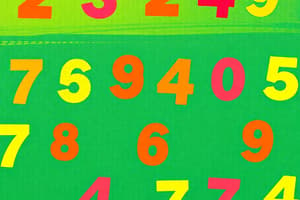Podcast
Questions and Answers
What is the next number in the pattern: 2, 5, 8, 11, 14?
What is the next number in the pattern: 2, 5, 8, 11, 14?
- 16
- 12
- 17 (correct)
- 15
Which of the following numbers is in the correct order from least to greatest?
Which of the following numbers is in the correct order from least to greatest?
- 3, 5, 7, 9 (correct)
- 3, 9, 5, 7
- 5, 3, 7, 9
- 9, 7, 5, 3
Which symbol is used to compare two numbers, where the first number is greater than the second number?
Which symbol is used to compare two numbers, where the first number is greater than the second number?
- ≠
- > (correct)
- =
- <
What is the correct order of the numbers 8, 12, 15, 20 from greatest to least?
What is the correct order of the numbers 8, 12, 15, 20 from greatest to least?
What is the pattern in the sequence: 10, 15, 20, 25, 30?
What is the pattern in the sequence: 10, 15, 20, 25, 30?
What is the result of converting the fraction 2/5 to a decimal?
What is the result of converting the fraction 2/5 to a decimal?
In finance, what is the decimal equivalent of a 15% interest rate?
In finance, what is the decimal equivalent of a 15% interest rate?
In cooking, what is the decimal equivalent of 3/4 cup of sugar?
In cooking, what is the decimal equivalent of 3/4 cup of sugar?
What is the difference between a terminating and a repeating decimal?
What is the difference between a terminating and a repeating decimal?
What is the decimal equivalent of 1/2?
What is the decimal equivalent of 1/2?
In health and medicine, what is the decimal equivalent of a dosage of 1/4 mg of medication?
In health and medicine, what is the decimal equivalent of a dosage of 1/4 mg of medication?
Flashcards are hidden until you start studying
Study Notes
Number Sense
Number Patterns
- The ability to recognize and create patterns using numbers
- Examples:
- Counting by 2s, 5s, 10s, etc.
- Identifying patterns in sequences (e.g., 2, 5, 8, 11, 14)
- Creating number patterns using shapes or colors
Ordering Numbers
- The ability to arrange numbers in a logical order
- Examples:
- Ordering numbers from least to greatest (e.g., 3, 5, 7, 9)
- Ordering numbers from greatest to least (e.g., 9, 7, 5, 3)
- Comparing numbers using greater than (>), less than (<), and equal to (=) symbols
Comparing Numbers
- The ability to determine the relationship between two or more numbers
- Examples:
- Comparing numbers using greater than (>), less than (<), and equal to (=) symbols
- Determining if a number is greater than, less than, or equal to another number
- Using benchmarks (e.g., 10, 20, 50) to compare numbers
Estimation
- The ability to make an educated guess about a number or quantity
- Examples:
- Estimating the number of objects in a group
- Estimating the result of a calculation (e.g., 4 x 6 ≈ 24)
- Rounding numbers to the nearest ten, hundred, or thousand
Place Value
- The value of a digit based on its position in a number
- Examples:
- Understanding the value of digits in a number (e.g., hundreds, tens, ones)
- Recognizing that the value of a digit changes based on its position (e.g., 4 in 400 vs. 4 in 40)
- Using place value to compare and order numbers
Number Sense
Number Patterns
- Recognizing and creating patterns using numbers, such as counting by 2s, 5s, 10s, etc.
- Identifying patterns in sequences, for example, 2, 5, 8, 11, 14
- Creating number patterns using shapes or colors to visually represent the pattern
Ordering Numbers
- Arranging numbers in a logical order, such as ordering from least to greatest, e.g., 3, 5, 7, 9
- Ordering numbers in reverse, from greatest to least, e.g., 9, 7, 5, 3
- Comparing numbers using greater than (>), less than (<), and equal to (=) symbols
Converting Fractions to Decimals
- Divide the numerator by the denominator to convert a fraction to a decimal.
- Fractions can be converted to decimals using long division or a calculator.
- Decimals can be terminating or repeating.
Characteristics of Decimals
- Terminating decimals have a finite number of digits (e.g., 1/2 = 0.5).
- Repeating decimals have an infinite repeating pattern (e.g., 1/3 = 0.333...).
Real-World Applications of Decimals
Finance and Business
- Interest rates can be represented as decimals (e.g., 25% = 0.25).
- Investment returns can be represented as decimals (e.g., 12.5% = 0.125).
- Prices can be represented as decimals (e.g., $0.50).
Science and Engineering
- Precise measurements can be represented as decimals (e.g., 12.5 cm = 0.125 m).
- Mathematical calculations can be represented as decimals (e.g., πr^2 = 3.14r^2 approximately).
Cooking and Recipes
- Ingredient proportions can be represented as decimals (e.g., 0.25 cups of sugar).
- Cooking times can be represented as decimals (e.g., 2.5 hours).
Health and Medicine
- Medication dosages can be represented as decimals (e.g., 0.5 mg of medication).
- Medical measurements can be represented as decimals (e.g., 120.5 mmHg blood pressure reading).
Studying That Suits You
Use AI to generate personalized quizzes and flashcards to suit your learning preferences.




